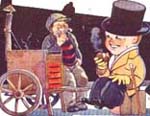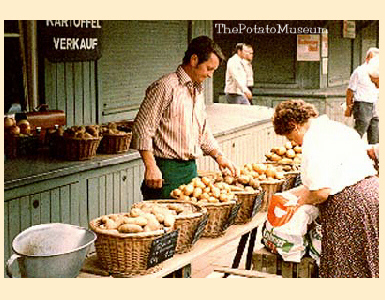
 |
 |
 |
 |
 |
 |
Potato Museum collection includes
|
The Potato Museum Timeline
1975 Tom Hughes and his 5th grade students create a classroom exhibit they call The Potato Museum, at the International School of Brussels (Belgium) 1976 Tom begins to collect potato memorabilia. The potato project continues as an after school club. The club sponsors a litter clean-up campaign in the community; the results include some 6,000 potato chip bags which are strung together as a garland. The chip bag garland decorates the playground for an afternoon of potato races and games. Local Belgian school children join in the festivities.
1977 The exhibit with Tom's collection expands to fill three unused classrooms and attracts community and press attention. 1978 Tom spends the summer researching the history of the potato. He attends the European Potato Association conference in Warsaw, Poland. Later he visits potato research centers in the USSR, the nations of Scandinavia and Germany. 1979 He resigns from his teaching position
to continue research. He visits 1980-83 Tom's potato passion (some call it an obsession) and his unique collection of artifacts earns him an invitation to tour the USA lecturing and presenting educational programs in schools and museums, and making media appearances. His appearance on Good Morning San Diego is so popular, the program invites him back the next day, something the station had never done before. As a guest on the Letterman show, Dave asks him why he didn't start a Brussels sprout museum. The Hugheses attend the American Potato Association annual meeting in Prince Edward Island, Canada. 1983 The Hughes family moves to Washington, DC. Tom begins teaching in McLean, Virginia.The collection continues to grow and is catalogued. 1984 Meredith writes The Great Potato Book for MacMillan Publishing, based on Tom's research. 1985 The Potato Museum collection is put on display in a small gallery space and opened by appointment. 1986 The Potato Museum incorporates as a non-profit. Two co-founders of The International Potato Center based in Lima, Peru serve on The Potato Museum's first board of directors. They are potato scientists Dr. Richard Sawyer, and Dr.John Niederhauser. 1987 Tom wins a Klingenstein Foundation award for excellence in teaching and studies potatoes in Peru with an Earthwatch expedition. Tom is invited to give a talk on the history and social influence of the potato at The International Potato Center in Lima. 1988 Meredith writes a paper which Tom delivers at the Asian Potato Conference Triennial in Kunming, China. The Hughes family tours China, Japan and Hawaii collecting for the museum. 1989 The Hugheses make a study/collecting trip to potato growing regions of the US Pacific Northwest...Idaho, Washington State, Oregon and California.
1990-1992 The Hugheses are guest curators for the Smithsonian's exhibition, "Seeds of Change: the Quincentenary of the Columbus Voyage to America." Simultaneously they work on "The Amazing Potato" the largest exhibition ever mounted by Canada's National Museum of Science and Technology in Ottawa.
The Potato Museum becomes a popular subject for the media. Visitors come from many countries and states to see the exhibit. Groups start to arrive. A delegation of docent trainees from Colonial Williamsburg includes The Potato Museum as part of their tour of DC sights. An American University professor brings her graduate students in museum studies to the museum. People bring their dates, have birthdays and celebrate special anniversaries in the exhibit rooms.
The Hugheses are participants in several conferences on food history, lecture at the United States National Arboretum, make an appearance on the Charlie Rose Show, (then a locally based Washington, DC late night interview program) and are too busy to accept an invitation to be guests on Larry King's radio talk show.
The Washington Post writes a glowing editorial on the occasion of The Potato Museum closing its exhibition after the landlord objected to all the extra traffic. 1993 The museum moves with the Hughes family to Albuquerque, New Mexico,and loans objects to an exhibit at the Maxwell Museum of Anthropology. The Potato Museum spins off a new entity, The FOOD Museum. The Hugheses broaden their research, collections and focus to the other foods of the Americas. Later they begin to take on all the world's foods. 1994 The Hugheses produce the museum's first food awareness programs for children and adults. They present these programs throughout the Rio Grande Valley library system, various schools, museums, senior centers and other venues in the Southwest 1995 Tom is invited to take an exhibit from The Potato Museum collection to Belgium. The City Museum of New York borrows items for an exhibit called "Gaelic Gotham." 1996 The Hugheses launch The FOOD Museum's website, www.foodmuseum.com 1997 The Hugheses begin to offer workshops to teachers, take teen programs to the Navajo reservation and teach summer school classes for Isleta Pueblo's Gifted and Talented Project. 1998-2000 Meredith writes ten books for the award-winning Plants We Eat series published by Lerner. 2001 Irish Television documentary features The Potato Museum collection and the work of Tom and Meredith in promoting the importance of the role of the potato in history. 2002-2003 The Hugheses take their popular program "Planet Potato" on the road to diverse audiences in Texas, Arizona, Minnesota, Missouri and California. El Camino Real International Heritage Center hires us to present educational programs in schools and festivals in Southern New Mexico. 2004-05 The Hugheses travel throughout France, Belgium and the UK researching a series of guidebooks on food museums and heritage sites. Discussions begin on establishing a permanent home in Europe for The Potato Museum. America: "Why We Love
Her"
Notice that The Potato Museum is the only listing |
"The
Potato Museum...that idiosyncratic and deadly serious institution." "The Potato Museum is of the new modern type,
which cuts across academic frontiers; it's an enthusiast's museum and
our hard, cold, cynical world desperately needs enthusiasm." "....a museum that gives sustenance the kind
of attention museums give to wars, airplanes, human tragedy and the
like." "The most important issue confronting the human
race is how we are going to preserve the quality of the environment
and still feed the rapidly growing population into the next millennium.
The Potato Museum provides a vehicle to get the message across."
|
| Copyright: The Potato
Museum 2005 About |Potato Blog |Links | Contact Us | Educators | Visitor Comments | Shop | Home |